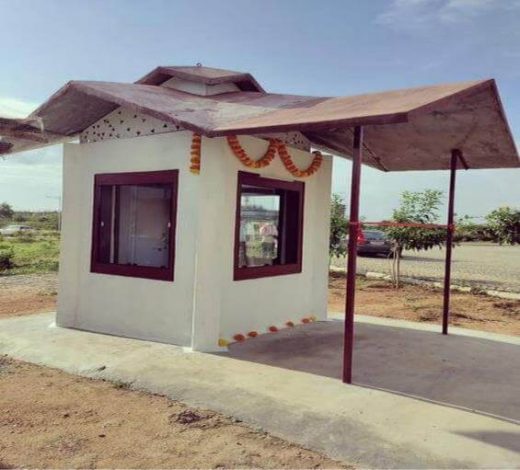Recently, the first bio-brick-based building in India was inaugurated at IIT Hyderabad on 2nd September 2021. It is a part of the project BUILD (Bold Unique Idea Lead Development) to demonstrate the strength and versatility of the material. It is a sample building that is made of bio-bricks and supported by a metal framework. It is a perfect example of “wealth from waste”. The roof of the sample building is made of bio-bricks over PVC sheets. It helps to reduce heat. The inside and outside walls of the house are cement plastered to protect the bio-bricks from rain.

Fig 1: India’s first bio-brick based building, IIT Hyderabad
What are Bio-Bricks
Nowadays agricultural waste is a burning source of land pollution in India. It is more significant after the harvesting season is over. Bio-Bricks are an alternative solution for this problem. Fired clay brick which is a major constituent material of the construction industry, produces a large amount of greenhouse gases. Researchers are trying to find alternative solutions and materials and how they can be modulated to suit the Indian construction Industry. Using technology, the agro wastes are converted into sustainable building material to build an eco-friendly and cost-effective building. It acts as an alternative to stubble burning. The bio-brick material has good thermal and sound insulation and has an overall negative carbon footprint. The brick is breathable and helps in maintaining a comfortable living condition during harsh summer or cold winters. Due to its low density, it reduces the dead load in the building
Significance of the Brick:
1. The bricks are economical. The farmers can make the brick material at the site and it can
reduce the labour costs.
2. The technology is developed to reduce the air pollution caused by stubble burning.3. The material has fire-retardant properties besides thermal insulation. It can reduce heat gain
by 5-6 degrees when used in roofing and wall paneling.
4. Bio-bricks can add to the marginal farmer’s income and it can create job opportunities at the
grassroots level during the lean period (off-season).
5. The bricks are having less weight. It is found to be and of weight for similar volume
compared to burnt clay bricks and concrete blocks respectively.
6. Bio-bricks will cost about Rs.2-Rs.3less when mass-produced, as compared to burnt clay
bricks.
7. Use of bio-bricks will allow villagers to build low-cost effective buildings.
Conclusion:
India is home to diverse agricultural crops. In every season agricultural wastes are generated. Their disposal also creates problems. At the same time demand for construction materials like bricks is ever increasing in Indian Construction Industries. Thus converting agricultural wastes into bio-bricks could help in mitigating the issues of raw materials required by construction industries and the pollution created by stubble burning of these. We need to inspire and motivate architects, designers, researchers, and builders to encourage and support the development of such sustainable and eco-sensitive materials in the construction industry.
If you have a query, you can ask a question here.


